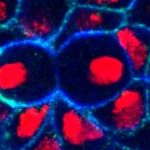Lien vers Pubmed [PMID] – 7958912
Genes Dev. 1994 Oct;8(20):2491-503
We have purified the sequence-specific DNA-binding protein KBF2 and cloned the corresponding cDNA, which is derived from the previously described RBP-J kappa gene, the human homolog of the Drosophila Suppressor of Hairless [Su(H)] gene. Deletion studies of the RBP-J kappa and Su(H) proteins allowed us to define a DNA-binding domain conserved during evolution. Because Su(H) mutant alleles exhibit dose-sensitive interactions with Hairless (H) loss-of-function mutations, we have investigated whether the RBP-J kappa or Su(H) proteins directly interact with the H protein in vitro. We show here that H can inhibit the DNA binding of both Su(H) and RBP-J kappa through direct protein-protein interactions. Consistent with this in vitro inhibitory effect, transcriptional activation driven by Su(H) in transfected Drosophila S2 cells is inhibited by H. These results support a model in which H acts, at least in part, as a negative regulator of Su(H) activity. This model offers a molecular view to the antagonistic activities encoded by the H and Su(H) genes for the control of sensory organ cell fates in Drosophila. We further propose that a similar mechanism might occur in mammals.

